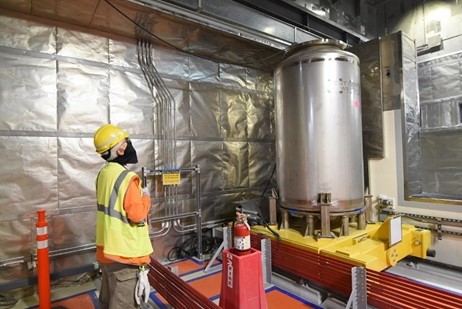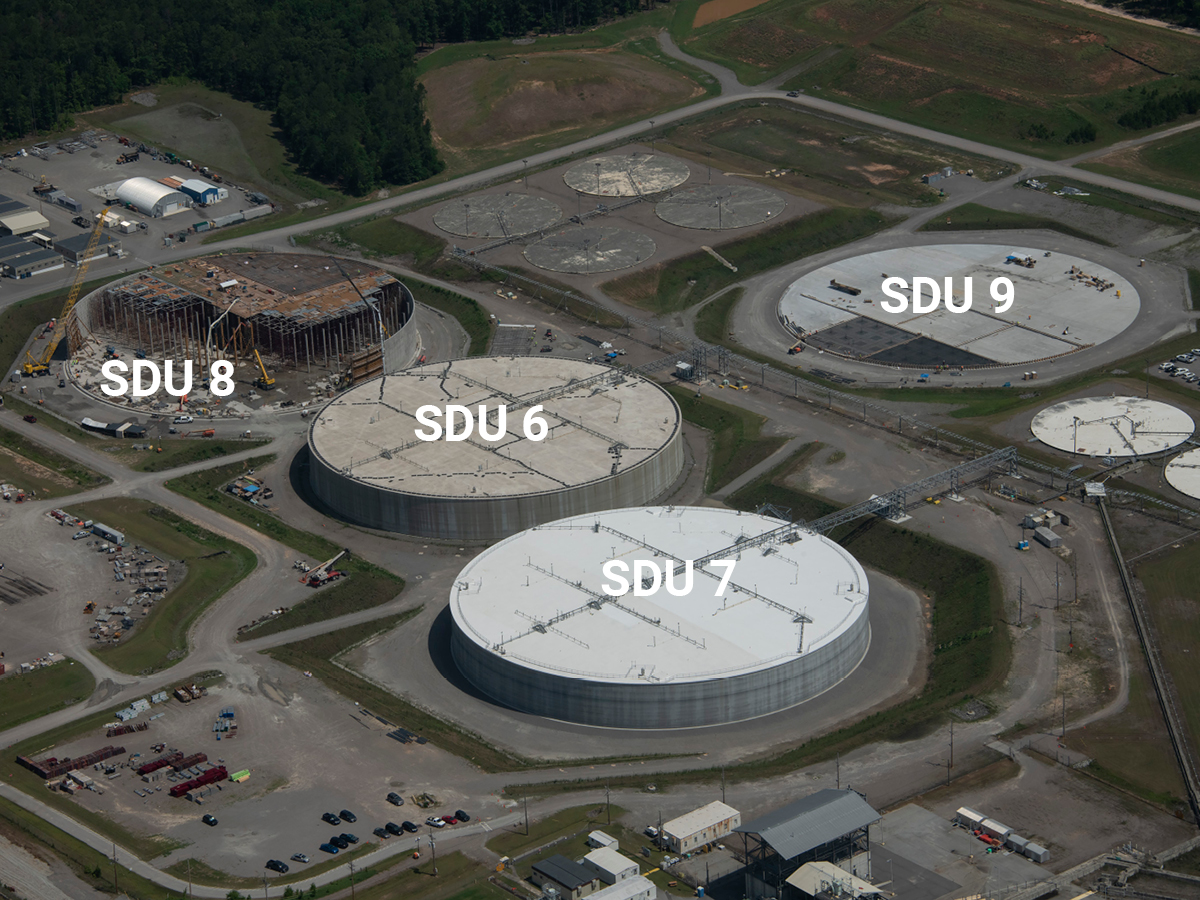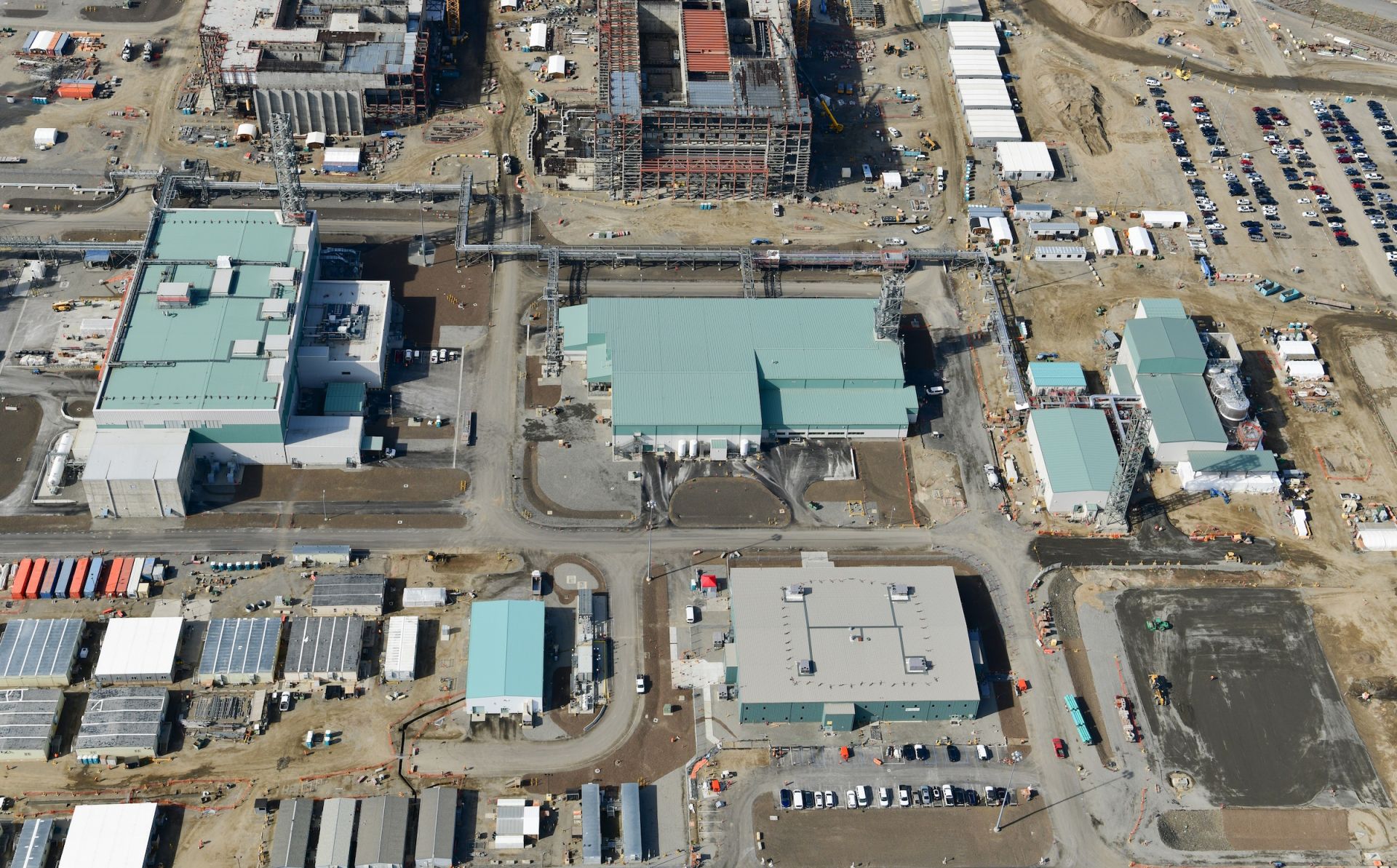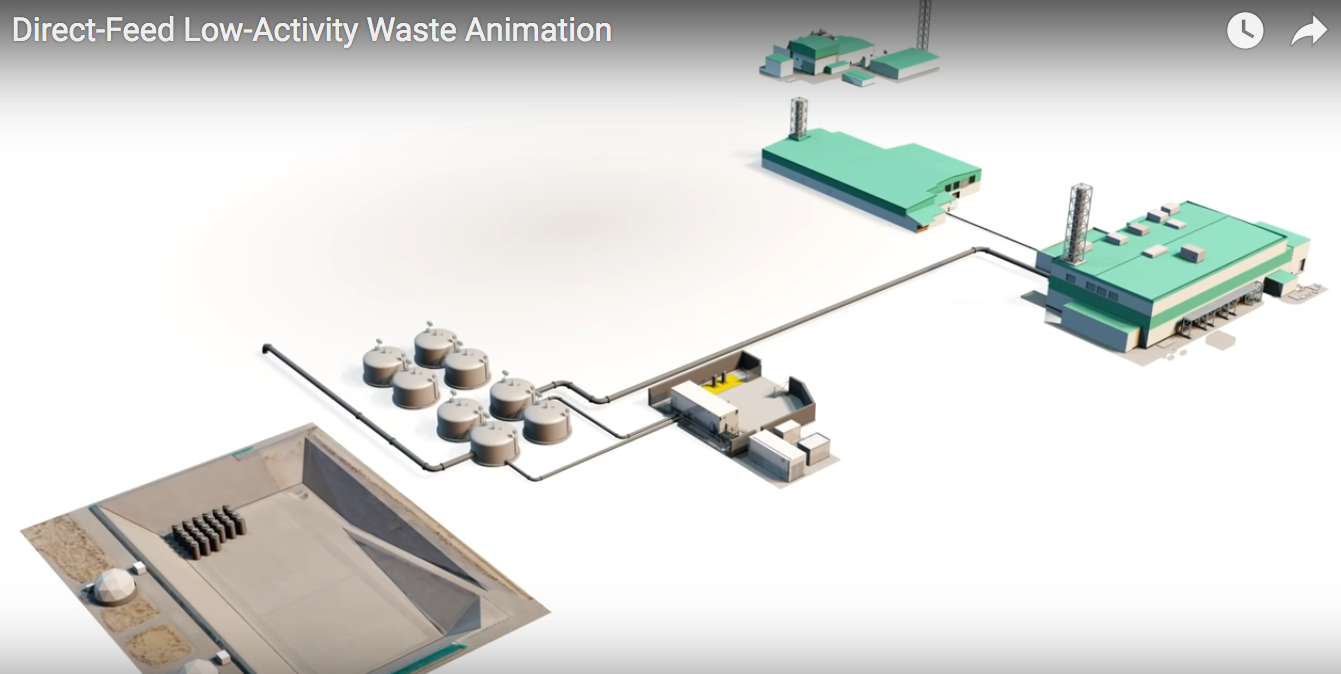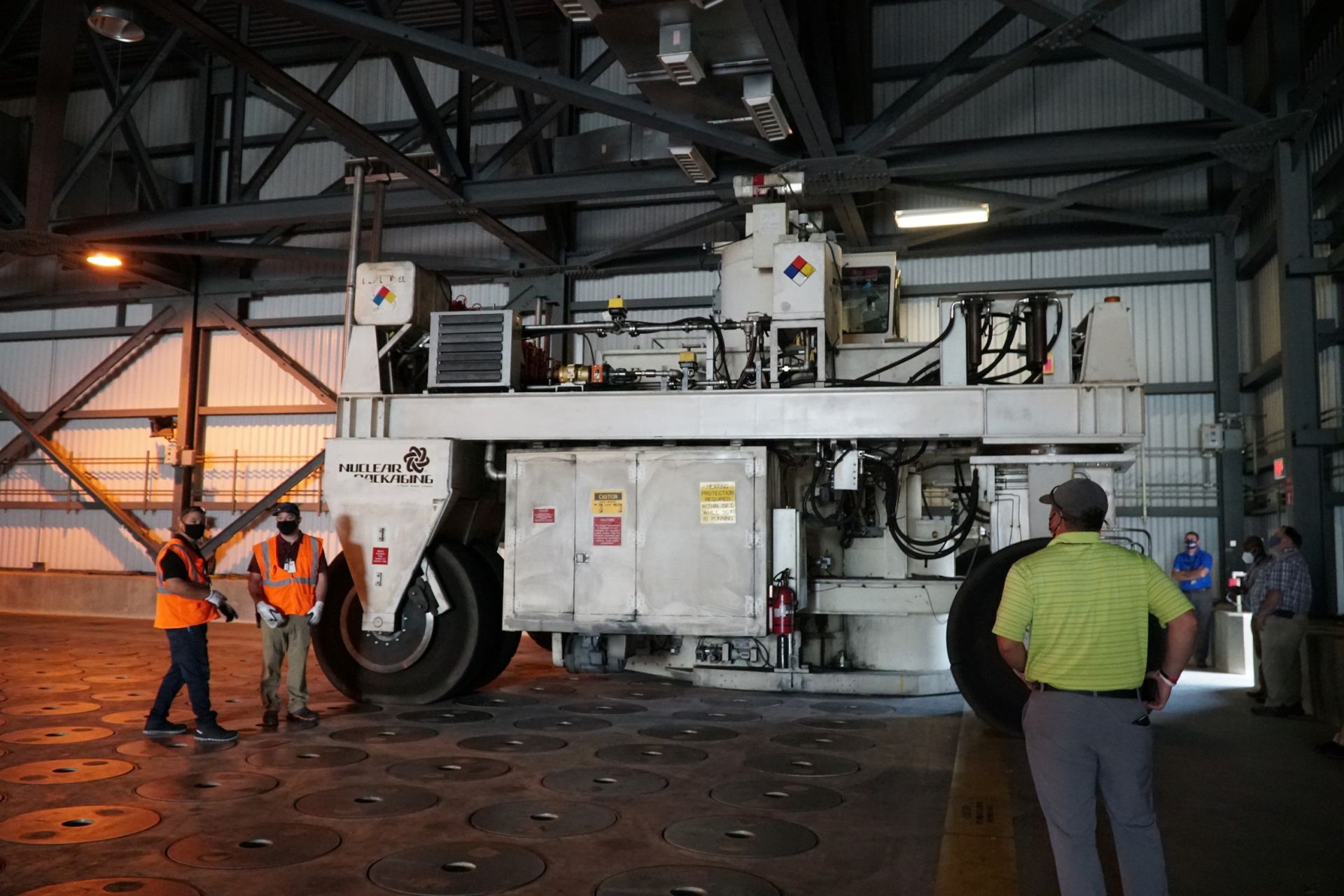Spent fuel in dry cask storage at the closed Kewaunee nuclear power plant. (Photo: NAC International)
The Department of Energy has restarted its consent-based siting process for identifying sites to store the nation’s spent nuclear fuel. Yesterday, the DOE issued a request for information that “will be used to further develop DOE’s consent-based siting process and overall waste management strategy in an equitable way.”
Electrician Ralph Bisla conducts tests of the finishing line inside Hanford’s WTP Low-Activity Waste Facility. (Photo: DOE)
Having completed all startup testing of components and systems, the Waste Treatment and Immobilization Plant (WTP) at the Hanford Site near Richland, Wash., has moved to the commissioning phase, the Department of Energy’s Office of Environmental Management (EM) announced last week. During the commissioning phase, the final steps will be taken to prepare for the vitrification of radioactive and chemical waste as part of Hanford’s Direct-Feed Low-Activity Waste (DFLAW) program.
Crews pump waste from Hanford’s single-shell tanks to more stable double-shell tanks. (Photo: DOE)
The Department of Energy is considering solidifying 2,000 gallons of Hanford’s tank waste and disposing of it as low-level radioactive waste at an off-site facility. A virtual public meeting on the proposed disposal plan is scheduled for November 18.
DOE liquid waste contractor Savannah River Remediation is moving forward with Saltstone Disposal Unit projects to support the Salt Waste Processing Facility at the Savannah River Site.
The Department of Energy’s Office of Environmental Management (EM) has authorized the use of a second mega-volume saltstone disposal unit (SDU) at the Savannah River Site in South Carolina. Savannah River Remediation (SRR), EM’s liquid waste contractor at SRS, received Critical Decision-4 for Saltstone Disposal Unit 7, marking the final step in the approval process before beginning operations.
Southern California Edison has a plan—and it just might build momentum to solve the nation’s spent nuclear fuel disposal dilemma.
Imagine it’s January 1998. A specially equipped train from the Department of Energy rolls up to the San Onofre Nuclear Generating Station (SONGS) to pick up spent nuclear fuel and take it to the Yucca Mountain repository in Nevada. This scene is repeated thousands of times at nuclear plant sites across the U.S. over the ensuing decades. The solution to permanent spent fuel disposal as outlined in the Nuclear Waste Policy Act (and its amendments) is working as intended. The nation’s commercial spent fuel is safely isolated deep underground for the long term.
But that is not what happened. Work on Yucca Mountain has been stalled for a full decade, and the organization within the DOE that by law is responsible for managing the spent fuel program has been defunded and disbanded.
Research teams from the NWMO and the University of Guelph conduct eDNA sampling in the Ignace area of Ontario, Canada. (Photo: NWMO)
Canada’s Nuclear Waste Management Organization (NWMO) is working with the University of Guelph to launch a joint environmental DNA (eDNA) research program to further understand biodiversity conditions around two potential sites in Ontario for a deep geological repository for spent nuclear fuel.
Sealed steel containers of uranium mill tailings are loaded onto railcars at the DOE’s Moab Site in preparation for transport to the Crescent Junction disposal cell. (Photo: DOE)
The Department of Energy’s Office of Environmental Management (EM) announced that it has accomplished another of its 2021 priorities by permanently disposing of a cumulative 12 million tons of uranium mill tailings from the Moab Site in Utah. The announcement, made on October 26, follows last week’s report by EM that it has shipped more than 1 million tons of tailings for disposal in fiscal year 2021, which ended on September 30, the largest annual amount since FY 2012.
Hanford’s Waste Treatment and Immobilization Plant, also known as the Vit Plant. (Photo: Bechtel National)
The Department of Energy’s Office of Environmental Management (EM) has issued a final request for proposal (RFP) for the Hanford Integrated Tank Disposition Contract, a 10-year, $45 billion deal to oversee waste tank operations at the DOE’s Hanford Site near Richland, Wash. Proposals are due by December 20.
A screen shot from Hanford’s DFLAW animation. (Image: DOE)
The Department of Energy’s Office of Environmental Management (EM) has released an animated video of the Direct-Feed Low-Activity Waste (DFLAW) Program at the Hanford Site near Richland, Wash. The video shows the integrated procedure for treating Hanford’s radioactive tank waste, a process EM says is a key component of its strategic cleanup vision.
View the animation here.
In a virtual ceremony, CNL and KHNP signed a memorandum of understanding to cooperate on spent CANDU fuel research. (Image: CNL)
Canadian Nuclear Laboratories (CNL) and Korea Hydro and Nuclear Power (KHNP) intend to leverage data collected over decades on the dry storage of spent nuclear fuel to help inform decision-making on future spent fuel storage, transportation, and disposal activities.
A view of the final remaining hot cell at the former Radioisotope Development Laboratory at Oak Ridge National Laboratory as it is prepared for demolition. (Photo: DOE)
Using a specialized radiation detector, Department of Energy cleanup contractor UCOR is characterizing a hot cell at Oak Ridge National Laboratory in preparation for its demolition. The detector overlays a radiation-intensity color-map on a picture of the environment and identifies gamma-emitting nuclides and their locations.
An electric continuous miner machine chews through the last wall of salt in Panel 8’s Room 7 of the Waste Isolation Pilot Plant to complete the rough cut of the panel. (Photo: DOE)
The Department of Energy’s Office of Environmental Management this week announced that after seven years, mining of the Waste Isolation Pilot Plant’s Panel 8 is finished. Created from an ancient salt formation 2,150 feet below the surface, Panel 8’s seven emplacement rooms are the next destination for transuranic waste brought to WIPP from DOE sites throughout the country.
Inside the New Safe Confinement covering the sarcophagus of Chernobyl’s Unit 4. (Photo: SSE Chornobyl NPP)
A team of scientists from the United Kingdom’s University of Bristol were given access to the Chernobyl nuclear power plant in Ukraine, advancing a project to train robots and artificial intelligence systems to measure radiation and create 3D maps.
A slideshow of the team’s visit to Chernobyl’s Unit 4 control room and New Safe Confinement structure, where they deployed radiation mapping and scanning sensors, including a LIDAR-equipped robot call Rooster, appears on Gizmodo.
Nitya Chandran, a facility engineer with the Washington State Department of Ecology, inspects Hanford’s tank-side cesium removal system. (Photo: DOE)
Washington state and Oregon will receive approximately $33.5 million through four financial assistance grants from the Department of Energy to fund programs related to the cleanup of the department’s Hanford Site near Richland, Wash. The grants will support environmental response regulatory activities, emergency preparedness, and public information programs in the two states.
All four grants, which were noncompetitively awarded, are for fiscal years 2022 through 2026.
Savannah River Remediation workers double-stack HLW canisters in an underground vault in Savannah River’s Glass Waste Storage Building 2 using a one-of-a-kind shielded canister transporter. (Photo: DOE)
The Department of Energy’s Office of Environmental Management (EM) has demonstrated the capability to expand the double-stacking of high-level waste canisters at the Savannah River Site in South Carolina. That approach will save the site’s cleanup program millions of dollars, according to the DOE.
The Sodium Pump Test Facility was the last DOE building to be demolished at the Energy Technology Engineering Center site in California. (Photo: DOE)
The demolition of the final of 18 DOE-owned buildings at the Energy Technology Engineering Center (ETEC) has been completed, according to the DOE. The ETEC is the former liquid metals research facility located at the Santa Susana Field Laboratory (SSFL), northwest of Los Angeles.

Markey

Levin
Sen. Edward J. Markey (D., Mass.) and Rep. Mike Levin (D., Calif.) have introduced the Nuclear Waste Task Force Act. The legislation is intended to establish a new task force to consider the implications of amending the Atomic Energy Act of 1954 to remove exemptions from environmental laws for nuclear waste. Eliminating this loophole could help enable consent-based siting of long-term storage solutions for spent nuclear fuel and high-level radioactive waste, the lawmakers said.
Intended to continue the work of 2012's Blue Ribbon Commission on America’s Nuclear Future, the task force would also be responsible for providing a clear explanation of what constitutes “consent-based siting.”
Spent nuclear fuel in dry storage at the decommissioned Zion nuclear power plant in Illinois.
Congress needs to take action to break the impasse over a permanent solution for commercial spent nuclear fuel, according to a report by the U.S. Government Accountability Office. The GAO recommends that Congress amend the Nuclear Waste Policy Act (NWPA) to authorize a new consent-based siting process, restructure the Nuclear Waste Fund, and direct the Department of Energy to develop and implement an integrated waste management strategy.
The GAO also recommends that the DOE finalize the consent-based process it began in 2015 for siting consolidated interim storage and permanent geologic repository facilities. The DOE agrees with that recommendation.
During a fluorescence spectroscopy experiment at LLNL, the protein lanmodulin makes radioactive curium glow when exposed to UV light in the sample to the right. The schematic (left) represents the structure of the curium-protein complex, with three curium atoms bound per molecule of protein. (Photo: LLNL)
Scientists at Lawrence Livermore National Laboratory, working in collaboration with researchers at Penn State University and Harvard Medical School, have discovered a new mechanism by which radionuclides could spread in the environment.
The research, which has implications for nuclear waste management and environmental chemistry, was published in the Journal of the American Chemical Society on September 20.
The headframe and buildings at the Gorleben salt dome in Germany. (Photo: Wikimedia Commons)
The German government has announced that it is closing the Gorleben salt mine in the Wendland region of Lower Saxony, officially removing the site from consideration as a repository for radioactive waste. Gorleben became a target of antinuclear protests after being proposed as a potential repository in the 1970s.



